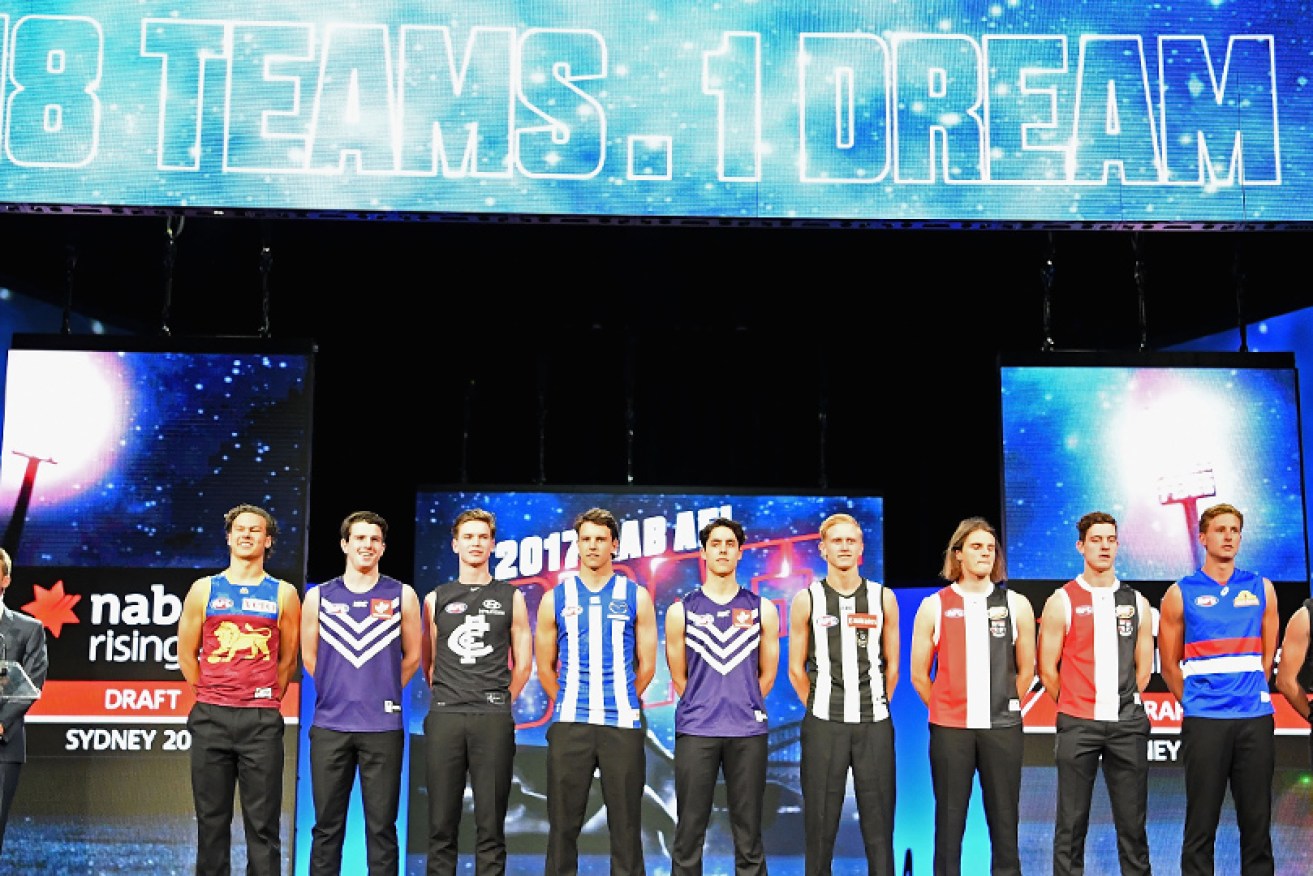The AFL draft will find new superstars but it sets up many more to fail


The AFL draft top 10 of 2017 get ready to live the dream. Photo: Getty
This week nearly 80 young men will take a significant step towards fulfilling their sporting dreams. Another 800 will have those same dreams shattered.
Welcome to the cut-throat world of the AFL draft.
The new 24-hour gap between the top 10 and remaining picks allows the media and supporters time to focus on and celebrate the most talented young players in the land. In reality, the system gives us time to intensely scrutinise and judge their worthiness before they have even played a game.
In my opinion, we need less focus on the draft, not more.
We need to lessen the focus on producing ready-made players at age 18 and increase the focus on producing outstanding young men. Talent will still rise to the top while the remainder will gain invaluable life skills they can take into work, study, relationships and sport.

No pressure, kid. Brisbane coach Chris Fagan and 2017 No.1 pick Cam Rayner. Photo: Getty
Unfortunately those infatuated with US sports at AFL House don’t get it.
Overexposing young men into an increasingly hostile social and mainstream media climate is unhealthy. Just ask the ever-increasing number of players taking time off to deal with mental health issues how all-consuming and invasive it can be.
Let’s not forget the 90 per cent who miss out on being drafted – the added exposure only increases and extends their disappointment levels. We’re creating a vicious cycle.
Recruiting is still an extremely unreliable activity. There are no Moneyball type statistics that accurately predict future success. There are no programs that spit out ready-made players like the US college system does. The best we have is Victoria’s TAC Cup program.
Cam Rayner, Andrew Brayshaw and Paddy Dow are all smiles backstage in their new guernseys #AFLDraft pic.twitter.com/pJBo1A9QWL
— AFL (@AFL) November 24, 2017
The TAC Cup exists solely to produce draftable talent. Anti-density rules and bans on tagging are designed to showcase individual skills to the ever-present horde of recruiters.
All other states adopt the traditional thirds system with under-18 teams associated with South Australian National Football League, West Australian Football League or Queensland Australian Football League teams.
If a kid has talent they’re often promoted to reserves or seniors and rarely play in their age group. In these systems development can often take a back seat to the importance of winning.
On the other end of the scale, TAC kids are ‘prepared’ for AFL via a bombardment of information and training for 11 months of the year. It’s a full-on program and a momentous task when it is combined with grassroots football, national carnivals and, most importantly, year 12 studies.
To find out if the system is working well, I asked an AFL recruiter friend a specific question: Are players who come through the TAC system preferred to those who don’t?

The draft class of 2018 – Rhylee West, Jack Lukosius, Ian Hill, Sam Walsh and Tarryn Thomas. Photo: Getty
The answer was: Not really.
As expected, the main advantage of the TAC program is that it puts most of the talented kids onto the same field, making comparisons far easier. Interestingly, the recruiter thinks there may be an advantage to being players “off Broadway” where the “big fish in the little pond” can look more attractive than they actually are.
There is no such thing as a complete product and AFL development coaches say they are spending more time each year working on the basics of the game. He suggests more time on the field and less in the classroom may be in order.
This year AFL talent ambassador and all-round draft guru Kevin Sheehan has just 22 TAC players in his predicted top 40 draftees.
Another friend, who is head of welfare at an AFL club, described his club’s attitude to draftees like this: “We can’t afford to assume anything, so we strip them down and teach them everything they need to know from scratch. That’s why we have different programs for each of the first, second, third and fourth-year players.”
“We need to make sure they can handle what an AFL life throws at them. We can’t and shouldn’t hand that responsibility over to junior coaches,” he said.
And here is the most telling comment: “If players fail to handle AFL life, it’s our fault. We’re the ones with all the resources and 24/7 access to the player. It’s not what they were or weren’t exposed to when they were juniors that matters most. People may assume we bring them in and spit them out but we don’t. These blokes are given every chance to succeed.”
If this is the case it begs the question as to why we demand 17-year-olds, in the last year of schooling, commit enormous amounts of time, effort and energy to doing something only a small percentage will achieve.
Collingwood legend Tony Shaw suggested the draft age should be lifted to 19 to avoid this very situation.
Less than 10 per cent of all draft nominees are selected, and the average length on an AFL list is just three years. Preparing players for life – not just football – makes a lot of sense.








